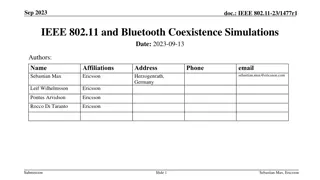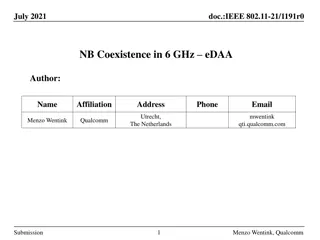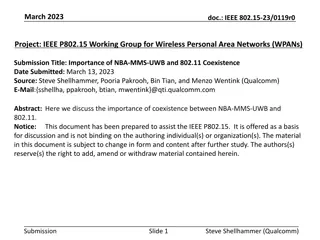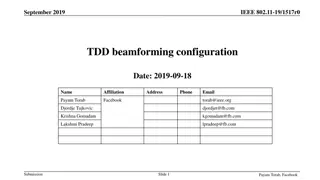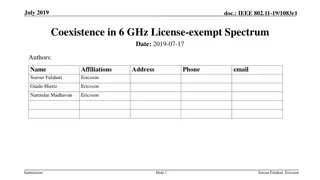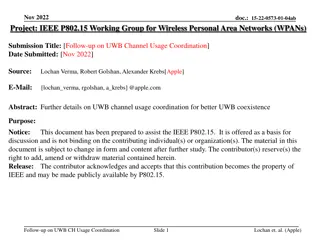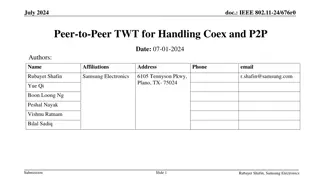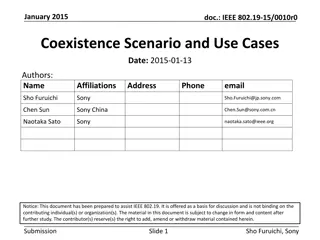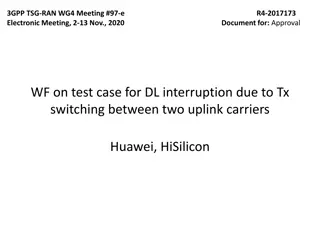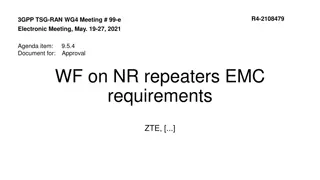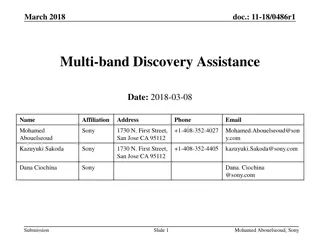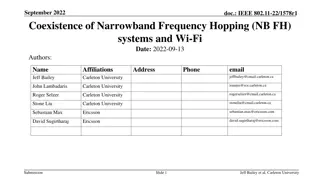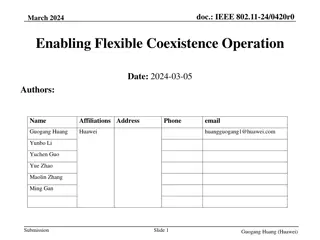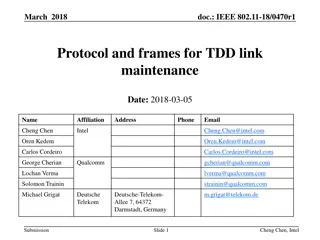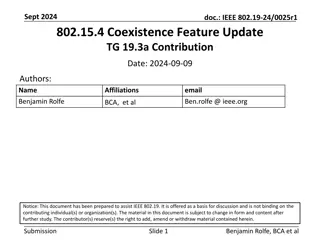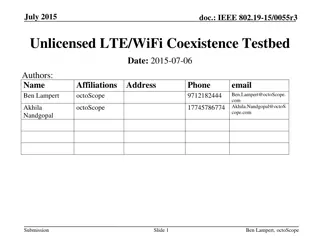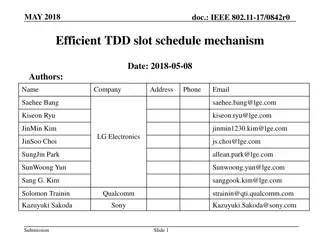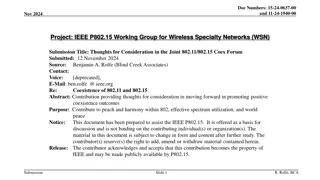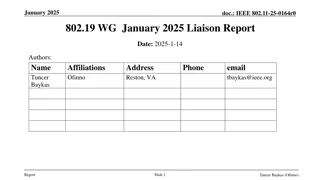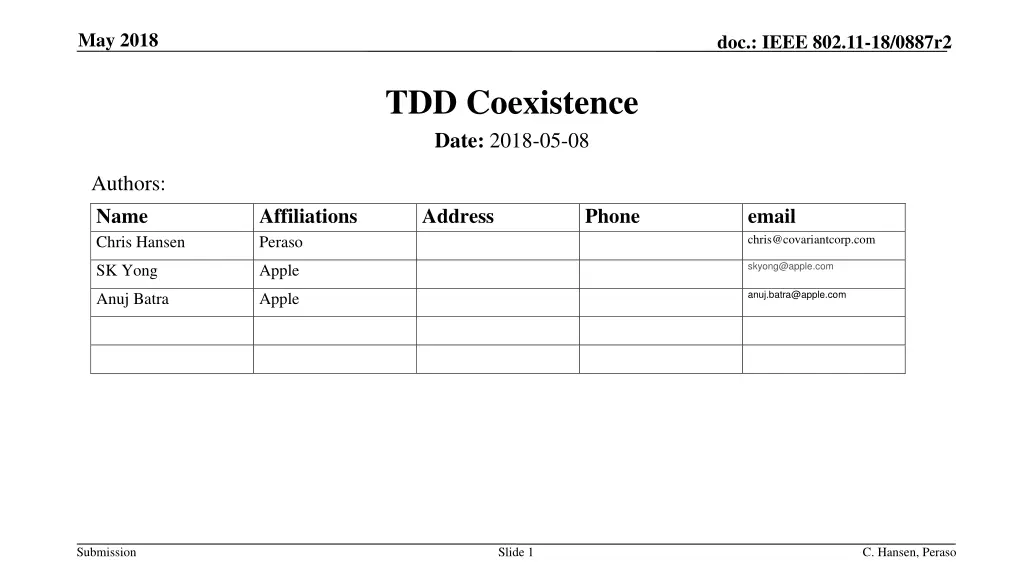
Understanding IEEE 802.11 TDD Coexistence Challenges
Explore the challenges of TDD coexistence in IEEE 802.11 networks, including issues with 802.11ay and 802.11ad, proposed remedies, background information, and the impact on legacy devices. Learn about the complexities of overlapping TDD and non-TDD networks and how these interactions affect network performance.
Download Presentation

Please find below an Image/Link to download the presentation.
The content on the website is provided AS IS for your information and personal use only. It may not be sold, licensed, or shared on other websites without obtaining consent from the author. If you encounter any issues during the download, it is possible that the publisher has removed the file from their server.
You are allowed to download the files provided on this website for personal or commercial use, subject to the condition that they are used lawfully. All files are the property of their respective owners.
The content on the website is provided AS IS for your information and personal use only. It may not be sold, licensed, or shared on other websites without obtaining consent from the author.
E N D
Presentation Transcript
May 2018 doc.: IEEE 802.11-18/0887r2 TDD Coexistence Date: 2018-05-08 Authors: Name Chris Hansen Affiliations Peraso Address Phone email chris@covariantcorp.com skyong@apple.com SK Yong Apple anuj.batra@apple.com Anuj Batra Apple Submission Slide 1 C. Hansen, Peraso
May 2018 doc.: IEEE 802.11-18/0887r2 Abstract Discussion of TDD Coexistence Issues with 802.11ay and 802.11ad Submission Slide 2 C. Hansen, Peraso
May 2018 doc.: IEEE 802.11-18/0887r2 Outline Background Fundamental technical issues for coexistence Protecting legacy devices Proposed remedies Submission Slide 3 C. Hansen, Peraso
May 2018 doc.: IEEE 802.11-18/0887r2 Background (1) IEEE 802.11-17/1288r2 Tgay Coexistence Assurance Document addresses coexistence of 802.11ay with legacy 802.11ad devices, as well as 802.11aj, and 802.15 devices 802.11ay Section 11.33 also addresses coexistence TDD creates new challenges that have not yet been addressed non-TDD STAs in an overlapping BSS will have no knowledge of a TDD SP Extended Schedule element is not shared from one BSS to another Reception of an Extended Schedule element in a Beacon or Announce frame from a neighboring BSS will be ignored With no knowledge of the rules of an SP, a non-TDD STA will revert to CBAP and wait until the medium is clear in order to transmit Submission Slide 4 C. Hansen, Peraso
May 2018 doc.: IEEE 802.11-18/0887r2 Background (2) TDD creates new challenges that have not yet been addressed (continued) STAs operating in TDD mode will not yield the medium to STAs in a non-overlapping BSS 11-18-0488-01-00ay has shown that fixed wireless access STAs can create overlapping BSS with both fixed wireless and more typical mobile wireless devices Coexistence measurements examined in 11-18-0488-01 underestimate the impact of interference, since real devices will be more sensitive than the CCA threshold requirement (-68 dBm) 11-18-0194-01-00ay advocates use of TDD for indoor consumer applications, which, if adopted, would make overlapping TDD / non-TDD common Submission Slide 5 C. Hansen, Peraso
May 2018 doc.: IEEE 802.11-18/0887r2 Overlapping TDD BSS / Non-TDD PBSS (1) Frames transmitted by the TDD STA during the TDD SP set the NAV at the Non TDD PCP (Either preamble or entire packet are received) Cannot transmit, nor respond to RTS The Non-TDD PBSS is essentially shut down when the TDD STA is transmitting When the TDD STA is receiving, the Non TDD PCP restarts, causing interference in the other direction TDD Frames TDD AP TDD STA Non TDD PCP Interference TDD Frames Non TDD STA Submission Slide 6 C. Hansen, Peraso
May 2018 doc.: IEEE 802.11-18/0887r2 Overlapping TDD BSS / Non-TDD PBSS (2) The structure of the TDD SP makes its usage with adjacent non-TDD PBSS/BSS problematic. Neighboring PBSS that is shutdown during TX TDD slots will start transmitting during RX RDD slots, creating interference into the TDD BSS. Interference into PBSS Here Interference from PBSS Here Submission Slide 7 C. Hansen, Peraso
May 2018 doc.: IEEE 802.11-18/0887r2 Protecting Legacy and Devices 802.11ay devices are obligated to co-exist with legacy 802.11ad and 802.15.3 devices TDD operation (as defined in D1.1 10.37.6.2.2 SP with TDD channel access) will not co-exist with a neighboring BSS/PBSS of any type, TDD, .11ay CBAP, or legacy CBAP Operation with TDD will require restrictions to prevent interference to neighboring PBSS/BSS Submission Slide 8 C. Hansen, Peraso
May 2018 doc.: IEEE 802.11-18/0887r2 Proposed Remedies Remedies to protect legacy and EDMG devices Mandate transmit power control during use of TDD Restrict the use of TDD to outdoor only Mandate channel sensing for overlapping BSS / PBSS before and during the use of TDD DMG Protected Period (802.11-2016 10.36.6.6) Remedies to protect EDMG devices Allow inter-PBSS / BSS signaling (TBD) to indicate interference from TDD Submission Slide 9 C. Hansen, Peraso
May 2018 doc.: IEEE 802.11-18/0887r2 Straw Poll Do you support adding mandatory co-existence mechanisms to the 802.11ay draft to protect DMG and EDMG STAs from DMG or EDMG STAs that are employing the TDD protocol? Do you support adding mandatory transmit power control mechanism(s) to the 802.11ay draft to protect DMG and EDMG STAs from DMG or EDMG STAs that are employing the TDD protocol? Submission Slide 10 C. Hansen, Peraso

